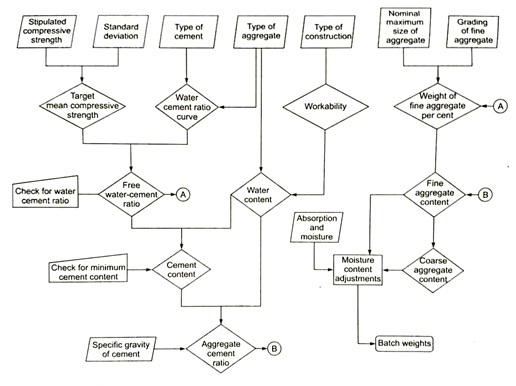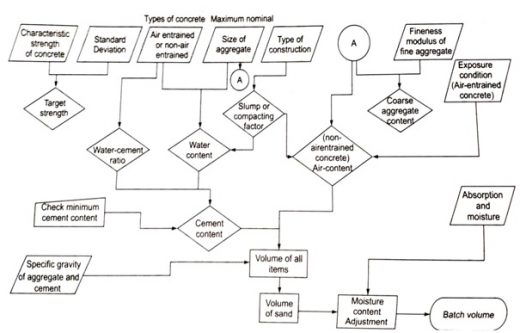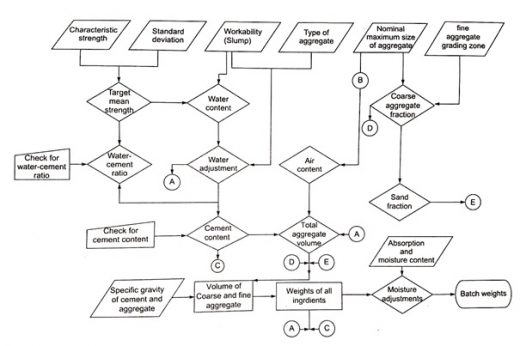INTRODUCTION
The available mix design methods are mostly dependent on charts, graphs and empirical relations from repetitive experiments following the same principle with a little bit of variations in different mix methods. Some of the commonly known design methods are-
1. Trial and Adjustment method of mix design
2. British DoE mix design method
3. ACI mix design method
4. Concrete mix proportioning-IS Guidelines
5. Rapid method for mix design
Generally following are the procedures followed for mix designing –
1. Maximum nominal size of aggregates is determined as per specifications and then gradings are determined.
2. Mean target strength is determined from level of quality control and characteristic strength.
3. Water cement ratio is selected as per suitability and it is compared with required durability.
4. Degree of workability I n terms of compacting factor or slump or Vee-Bee time is determined and water content as per workability is determined.
5. Cement content is calculated and checked for durability.
6. Percentage of fine aggregate in total aggregate is determined from characteristics of fine and coarse aggregates.
7. Concrete mix proportions for first trial mix is calculated and cubes of concrete are made for testing the compressive strength.
8. The trial batches are then tested till the final mix composition is reached.
9. Final proportions are expressed either on volume or mass basis.
TYPES
1. Trail and Adjustment method of Mix design
It is based on experimental approach in order to produce concrete mix having minimum voids. Proportioning of fine to coarse aggregate in order to obtain maximum mass is done by various trials. Here, in this process a container is filled with known volume having two materials in thin layers. The fine aggregates are placed over coarse aggregates but before that ramming is done lightly so as to have better compaction. Care should be taken not to shake the container too much otherwise fine aggregates will get deposited on bottom of cylinder pushing the coarse aggregates on top. This method needs least amount of cement per cubic metre and will be economical for a given slump and water cement ratio.
2. British Doe Method of Concrete Mix Design
It is a method that is developed by Department of Environment and is conformed to British Standards. This method is based on the characteristic value approach for strength, target mean for slump and air as well as target mean for cement content and water-cement ratio. The assumptions based on which the method is followed are –
1) Volume of freshly mixed concrete is equal to the sum of the absolute volumes of its constituent materials which are cement, water, air content and aggregates.
2) Compressive strength class of a concrete is based on
• Free water-cement ratio.
• Coarse aggregate type whether crushed or uncrushed.
• Cement type whether ordinary or combined.
3) Consistency of concrete depends on –
• Free water content
• Fine aggregate type as well as to a small extent coarse aggregate type.
• Maximum size of coarse aggregate.
• Grading of fine aggregate.
• Fine aggregate as a proportion of total aggregate.

FIG 1: CONCRETE MIX DESIGN FLOW CHART FOR DOE METHOD
COURTESY: CONCRETE TECHNOLOGY BY M L GHAMBHIR
3. ACI Method of Mixed Proportioning
The ACI method of mixed design is included in the section of guidelines published by the American Concrete Institute (ACI) in 1991. The guidelines were prepared for heavy-weight, normal and mass concrete mix design. The design steps are presented in the form of schematic flow chart as recommended by ACI Committee 211. This method is suitable for compressive strength of 45 MPa (28-day strength) and slump range for workability 25 to 100mm. ACI gave a table depicting relationship between nominal maximum aggregate size, slump desired and air entrainment to the required mixing water quantity.
| Type of Construction | Maximum Slump | Minimum Slump |
| Reinforced foundation walls and footings; plain footings, caissons and substructure walls | 75 | 25 |
| Beams and reinforced walls; building column | 100 | 25 |
| Pavement and slabs | 75 | 25 |
| Mass Concrete | 50 | 25 |
Table 1: Slump ranges for specific applications (after ACI, 2000)

FIG 2: CONCRETE MIX DESIGN FLOW CHART FOR ACI METHOD
COURTESY: CONCRETE TECHNOLOGY BY M L GAMBHIR
4. Concrete mix proportioning by IS Guidelines
All the requirements of IS 456:2000 is also satisfied in the mix design process. It is suitable for both ordinary and standard grades of concrete having compressive strength of 55 MPa (28-day strength) and slump range for workability 25 to 125 mm. The basic data required are characteristic strength, degree of workability, water cement ratio, properties of aggregates and minimum cement content. As per IS 456:2000 the characteristic strength is defined as the value below which not more than 5 percent of test results are expected to fail. IS 10262-2009: Concrete Mix Proportioning Guidelines can be used for mix proportioning of concrete using fly ash.

FIG 3: CONCRETE MIX DESIGN FLOW CHART FOR IS GUIDELINES
COURTESY: CONCRETE TECHNOLOGY BY M L GAMBHIR
5. Rapid Method for Mixed Design
It is a more realistic approach to mix design as 28 days are needed for determining the strength characteristics and another 28 days are needed for trial mixes of concrete. However, in order to cut down time required for trials, the Cement Research Institute of India (CRI) has developed an alternate rapid method which uses Accelerated Curing Method as per IS 9013: 1978. The procedure includes-
1. Testing of 150 mm cube is done for determining the accelerated strength of reference or standard concrete.
2. Corresponding accelerated strength of standard concrete is required to determine the water-cement ratio for target mean strength of normal concrete.
3. Mix proportions are determined by any method of mix design and it is checked for workability of fresh concrete.
4. 28-day compressive strength of normal concrete is estimated by using accelerated strength obtained.
CONCLUSION
Absolute volume concept is used for all the methods discussed above. Almost all the methods have same design parameters except IS Guidelines and ACI methods as they use volume fraction of coarse aggregates in calculation of fine aggregates content. British DoE is the method where the sand content is directly dependent upon maximum size of coarse aggregate and the grading zone of fine aggregate. Also, ACI method defines fine aggregate grading in terms of fineness modulus (FM). For high performance concrete other design methods are used to determine strength. As per suitability the design methods are adopted and used in various applications.
REFERENCES
M L Gambhir, “Concrete Technology”, Fifth Edition, Mc Graw Hills Education
from Civil Engineering Portal https://ift.tt/3hCKyWv


